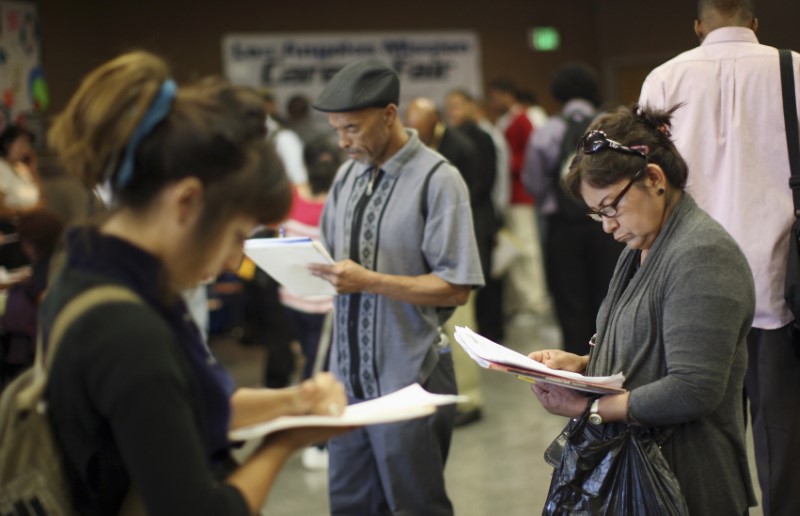By Lucia Mutikani
WASHINGTON (Reuters) - The number of Americans filing for unemployment benefits rose slightly last week and the four-week moving average of claims hit a 44-year low, suggesting a further tightening of the labor market that could encourage the Federal Reserve to raise interest rates next month.
The economy's brightening prospects were, however, dimmed somewhat by other data on Thursday showing the goods trade deficit widening in April and inventories decreasing, prompting analysts to pare their second-quarter GDP growth estimates.
"Businesses are wisely hoarding labor and not laying off workers because there are no skilled workers to fill these jobs at corporations and companies across the country," said Chris Rupkey, chief economist at MUFG Union Bank in New York.
Initial claims for state unemployment benefits increased 1,000 to a seasonally adjusted 234,000 for the week ended May 20, the Labor Department said. The increase followed three straight weeks of declines.
Economists had forecast first-time applications for jobless benefits rising to 238,000 in the latest week. It was the 116th straight week that claims were below 300,000, a threshold associated with a healthy labor market.
That is the longest such stretch since 1970, when the labor market was smaller. The labor market is near full employment, with the jobless rate at a 10-year low of 4.4 percent.
The four-week moving average of claims, considered a better measure of labor market trends as it irons out week-to-week volatility, fell 5,750 to 235,250 last week, the lowest level since April 1973.
The dollar (DXY) was trading marginally lower against a basket of currencies, while prices of U.S. Treasuries were slightly higher. U.S. stocks rose, with the Standard and Poor's 500 index (SPX) and Nasdaq Composite index (IXIC) hitting record highs.
ROBUST JOB MARKET Labor market strength supports the view that an abrupt slowdown in economic growth in the first quarter was probably temporary. Gross domestic product increased at a 0.7 percent annualized rate in the first quarter, the weakest performance in three years.
Minutes of the Fed's May 2-3 policy meeting, which were published on Wednesday, showed that while policymakers agreed they should hold off hiking rates until there was evidence the growth slowdown was transitory, "most participants" believed "it would soon be appropriate" to raise borrowing costs.
Data on the labor market, retail sales and industrial production suggest the economy regained momentum at the start of the second quarter.
But expectations of a sharp rebound in GDP growth were tempered after the Commerce Department reported on Thursday that the goods trade deficit rose 3.8 percent to $67.6 billion in April amid a drop in exports. At the same time, both wholesale and retail inventories fell 0.3 percent last month.
Trade made no contribution to GDP growth in the first quarter while inventory investment subtracted 0.93 percentage point from output. Economists cut their second-quarter GDP estimates by as much as half a percentage point to as low as a 2.0 percent rate after the release of Thursday's data.
"If the widening in the trade gap reported thus far in the quarter is sustained, trade would subtract about half a percentage point from second-quarter GDP growth," said John Ryding, chief economist at RDQ Economics in New York.
Thursday's claims report also showed the number of people still receiving benefits after an initial week of aid rose 24,000 to 1.92 million in the week ended May 13.
Still, the so-called continuing claims have now held below 2 million for six straight weeks. The four-week moving average of continuing claims dropped 16,000 to 1.93 million, the lowest level since January 1974.
The continuing claims data covered the survey period for May's unemployment rate. The four-week average of continuing claims decreased 76,750 between the April and May survey weeks, indicating further improvement in the unemployment rate.

The jobless rate has dropped by four-tenths of a percentage point this year.